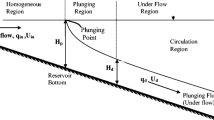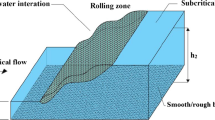Abstract
Predicting the accurate hydrodynamic pressure at plunge pool bottoms due to the impact of plunging high-velocity jets is essential in assessing the stability of the bed rock blocks and concrete slabs. In this context, the subsequent scour depth evaluation is essential. The regression-derived model of multiple nonlinear regression (MNLR) and two intelligent models of artificial neural network and adaptive neuro-fuzzy inference system are developed to predict the hydrodynamic pressure mean and hydrodynamic pressure fluctuations at flat and scoured plunge pool bottom. By running statistical analysis on a wide range of large-scale experimental data, it is revealed that, in general the intelligent models outperform the regression-derived equations of MNLR. The average values of RMSE and R2 in the prediction of hydrodynamic pressure coefficients are improved to 0.054 and 0.87, respectively. Nevertheless, due to its simplicity the empirical equations based on MNLR model are accurate enough for engineering applications. These equations predict both the dynamic pressure mean and root mean square of pressure fluctuations at flat bottoms and scoured bottoms more accurately than the available equations for this purpose, with 70% and 90% of data within 20% range of discrepancy, respectively. An empirical equation of pressure fluctuation at SB is introduced for the first time in this study.







Similar content being viewed by others
Abbreviations
- C p :
-
Mean dynamic coefficient
- C ׳ p :
-
RMS coefficient of pressures
- C + p :
-
Maximum pressure coefficient
- C − p :
-
Minimum pressure coefficient
- C i :
-
Aeration coefficient
- C * p :
-
Mean dynamic pressures of scoured bottom
- C ׳ * p :
-
RMS value of dynamic pressures of scoured bottom
- D 0 :
-
Diameter of jet at issuance
- D c :
-
Diameter of scour hole
- D j :
-
Jet diameter at tail water surface impact
- Frc :
-
Froude number of scoured pool
- g :
-
Acceleration due to gravity
- H :
-
Pressure head
- H ׳ :
-
RMS volume of pressure
- H max :
-
Maximum pressure head
- H min :
-
Minimum pressure head
- \(\overline{H}_{\rm m}\) :
-
Mean value of pressure
- L :
-
Falling height
- L b :
-
Disintegration length
- N :
-
Pressure sample count
- O :
-
Observed values
- \(\overline{O}\) :
-
Mean predicted values
- P :
-
Predicted values
- Q a :
-
Air discharge
- Q w :
-
Water discharge
- Re:
-
Reynolds number
- t :
-
Depth of scour hole
- Tu:
-
Turbulence intensity
- v' :
-
Velocity fluctuation
- V 0 :
-
Jet velocity at issuance
- V j :
-
Impact jet velocity at tail water surface
- Y :
-
Plunge pool water depth
- ρ :
-
Fluid density
- μ :
-
Dynamic viscosity of fluid
- β :
-
Air–water ratio
- η :
-
Turbulence jet coefficient
References
Aamir M, Ahmad Z (2019) Estimation of maximum scour depth downstream of an apron under submerged wall jets. J Hydroinform 21(4):523–540. https://doi.org/10.2166/hydro.2019.008
Annandale GW (1995) Erodibility. J Hydraul Res 33(4):471–494. https://doi.org/10.1080/00221689509498656
Asadollahi P, Tonon F, Federspied M, Schleiss A (2011) Prediction of rock block stability and scour depth in plunge pools. J Hydraul Res 49(6):750–756. https://doi.org/10.1080/00221686.2011.618055
Bellin A, Fiorotto V (1995) Direct dynamic force measurement on slabs in spillway stilling basins. J Hydraul End 121(10):686. https://doi.org/10.1061/(ASCE)0733-9429(1995)121:10(686)
Beltaos S, Rajaratnam N (1973) Plane turbulent impinging jets. J Hydraul Res 11(1):29–59. https://doi.org/10.1080/00221687309499789
Beltaos S, Rajaratnam N (1974) Impinging circular turbulent jets. J Hydraul Div 100(HY10):1313–1328
Bollaert E, Schleiss A (2001) Discussion of Simulation of scour process in plunging pool of loose bed material by Y. Jia, T. Kitamura, and S. S. Y. Wang. J. Hydraul. Eng. 128(7):721–723. https://doi.org/10.1061/(ASCE)0733-9429(2002)128:7(721)
Bollaert E (2002) Transient water pressures in joints and formation of rock scour due to high-velocity jet impact. PHD Thesis, Ecole Polytechnique Federale de Lausanne (EPFL), Lausanne, Switzerland.
Bollaert E, Schleiss A (2003a) Scour of rock due to the impact of plunging high velocity jets. Part I: a state-of-the-art review. J Hydraul Res 41(5):451–464. https://doi.org/10.1080/00221680309499991
Bollaert E, Schleiss A (2003b) Scour of rock due to the impact of plunging high velocity jets Part II: Experimental results of dynamic pressures at pool bottoms and in one and two-dimensional closed end rock joints. J Hydraul Res 41(5):465–480. https://doi.org/10.1080/00221680309499992
Bollaert E, Schleiss A (2005) Physically based model for evaluation of rock scour due to high-velocity jet impact. J Hydraul Eng 131(3):153–165. https://doi.org/10.1061/(ASCE)0733-9429(2005)131:3(153)
Carrillo JM, Castillo LG, Marco F, Garcia JT (2020a) Experimrntal and numerical analysis of two-phase flows in plunge pools. J Hydraul Eng. https://doi.org/10.1061/(ASCE)HY.1943-7900.0001763
Carrillo JM, Patricio R, Castillo LG, Garcia J (2020b) Experimental characterization of air entrainment in rectangular free falling jets. J. Water 12(6):1773. https://doi.org/10.3390/w12061773
Castillo L, Puertas J, Dolz J (1999) Discussion: Pressure fluctuations on plunge pool floors (Ervine DA, Falvey HT and Withers W). J Hydraul Res 37(2):272–277. https://doi.org/10.1080/00221689909498311
Castillo L, Carrillo M, Blazquez A (2014) Plunge pool dynamic pressures: a temporal analysis in the nappe flow case. J Hydraul Res 53(1):101–118. https://doi.org/10.1080/00221686.2014.968226
Castillo L, Carrillo J (2016) Scour, valocities and pressures evaluations produced by spillway and outlets of dam. J Water 8(3):68–89. https://doi.org/10.3390/w8030068
Cola R (1965) Energy Dissipation of a High Velocity Vertical Jet Entering a Basin. Proc., 11th Congr. of International Association for Hydraulic Research, Leningrad, USSR.
Duarte R (2014) Influence of air entrainment on rock scour development and block stability in plunge pools. PHD Thesis, Ecole Polytechnique Federale de Lausanne (EPFL), Lausanne, Switzerland
Duarte R, Schleiss A, Pinheiro A (2015) Influence of jet aeration on pressures around a block embedded in a plunge pool bottom. J Environ Fluid Mech 15:673–693. https://doi.org/10.1007/s10652-014-9392-x
Duarte R, Schleiss A, Pinheiro A (2016a) Effect of pool confinement on pressures around a block impacted by plunging aerated jets. Can J Civ Eng 43:201–210. https://doi.org/10.1139/cjce-2015-0246
Duarte R, Pinheiro A, Schleiss A (2016b) An enhanced physically based scour model for considering jet air entrainment. Elsev J Eng 2(3):294–301. https://doi.org/10.1016/J.ENG.2016.03.003
Ervine DA, Falvey HT, Withers W (1997) Pressure fluctuations on plunge pool floors. J Hydraul Res 35(2):257–279. https://doi.org/10.1080/00221689709498430
Federspiel M (2011) Response of an Embedded Block Impacted by high-Velocity Jets. PHD Thesis, Ecole Polytechnique Federale de Lausanne (EPFL), Lausanne, Switzerland.
Fiorotto V, Rinaldo A (1992a) Turbulent pressure fluctuations under hydraulic jumps. J Hydraul Res 30(4):499–520. https://doi.org/10.1080/00221689209498897
Fiorotto V, Rinaldo A (1992b) Fluctuation uplift and lining design in spillway stilling basins. J Hydraul Eng 118(4):578. https://doi.org/10.1061/(ASCE)0733-9429(1992)118:4(578)
Fiorotto V, Salandin P (2000) Design of anchored slabs in spillway stilling basins. J Hydraul Eng 126(7):502–512. https://doi.org/10.1061/(ASCE)0733-9429(2000)126:7(502)
Fiorotto V, Barjastehmaleki S, Caroni E (2016) Stability Analysis of plunge pool linings. J Hydraul Eng 142(11):04016044. https://doi.org/10.1061/(ASCE)HY.1943-7900.0001175
Franzetti S, Tanda MGS (1987) Analysis of turbulent pressure fluctuation caused by a circular impinging jet. In: International symposium on new technology in model testing in hydraulic research, India, pp 85–91
Guven A, Gunal M, Cevik A (2006) Prediction of pressure fluctuations on sloping stilling basins. Can J Civ Eng 33(11):1379–1388. https://doi.org/10.1139/l06-101
Hartung R, Hausler E (1973) Scours, stilling basins and downstream protection under free overfall jets at dams. In: Vol 1 of Proceedings of the 11th international congress on large dams, pp 39–56
Jang JSR, Shing R (1991) Fuzzy modeling using generalized neural networks and kalman filter algorithm. In: Proceedings of the 9th national conference on artificial intelligence, Anaheim, CA, USA, vol 2, pp 762–767
Jang JSR (1993) ANFIS: adaptive-network-based fuzzy inference system. IEEE Trans Syst Man Cybern 23(3):665–685. https://doi.org/10.1109/21.256541
Jia Y, Kitmura T, Wang SSY (2001) Simulation of scour process in plunging pool of loose bed-material. J Hydraul Eng 127(3):219. https://doi.org/10.1061/(ASCE)0733-9429(2001)127:3(219)
Karbasi M, Azamathulla H (2017) Prediction of scour caused by 2D horizontal jets using soft computing techniques. Ain Shams Eng J 8(4):559–570. https://doi.org/10.1016/j.asej.2016.04.001
Lencastre A (1961) Free Overflow Spillways. LNEC, Lisbon, Portugal, Report No. 174
Lopadro R (1988) Stilling basin pressure fluctuations. In: Proceedings of the international sympoisum on model-prototype correlation in hydraulic structures, Colorado Springs, Colorado, August, pp 56–73
Maleki Sh, Fiorotto V (2019) Scour due to a falling plane jet: a comprehensive approach. J Hydraul Eng 145(4):04019008. https://doi.org/10.1061/(ASCE)HY.1943-7900.0001564
Manso P, Bollaert E, Schlieiss A (2009) Influence of plunge pool geometry on high-velocity jet impact pressures and pressure propagation inside fissured rock media. J Hydraul Eng 135(10):783–792. https://doi.org/10.1061/(ASCE)HY.1943-7900.0000090
Manso P (2006) The influence of pool geometry and induced flow patterns in rock scour by high-velocity plunging jets. PHD Thesis, Ecole Polytechnique Federale de Lausanne (EPFL), Lausanne, Switzerland
May R, Willoughby I (1991) Impact pressures in plunge basins due to vertical falling jets. Report SR242, Hydraul. Res. Wallingford, Oxfordshire, United Kingdom
Melo JF, Pinheiro A, Ramos M (2006) Forces on plunge pool slabs: influence of joints location and width. J Hydraul Eng 132(1):49. https://doi.org/10.1061/(ASCE)0733-9429(2006)132:1(49)
Najafzadeh M, Balf MR, Rashedi E (2016) Prediction of maximum scour depth around piers with debris accumulation using EPR. MT and GEP models. J Hydroinform 18(5):867–884. https://doi.org/10.2166/hydro.2016.212
Roushangar K, Akhgar S, Salmasi F, Shiri J (2017) Neural networks- and neuro-fuzzy-based determination of influential parameters on energy dissipation over stepped spillways under nappe flow regime. ISH J Hydraul Eng 23(1):57–62. https://doi.org/10.1080/09715010.2016.1235472
Toso JW, Bowers CE (1988) Extreme pressures in hydraulic jump stilling basins. J Hydraul Eng 114(8):829–843. https://doi.org/10.1061/(ASCE)0733-9429(1988)114:8(829)
Wei W, Xu W, Deng J, Liu B (2020) Experimental study of impact pressures on deep plunge pool floors generated by submerged inclined jets with controlled aeration. J Hydraul Eng. https://doi.org/10.1061/(ASCE)HY.1943-7900.0001704
Acknowledgements
Appreciations are extended to Dr. Pedro Manso from EPFL, Switzerland for his constructive discussions regarding the range and validity of the experimental data.
Author information
Authors and Affiliations
Corresponding author
Rights and permissions
About this article
Cite this article
Fatahi-Alkouhi, R., Shanehsazzadeh, A. & Hashemi, M. Empirical Models for Hydrodynamic Pressure at Plunge Pool Bottoms Due to High-Velocity Jet Impact. Iran J Sci Technol Trans Civ Eng 46, 1359–1374 (2022). https://doi.org/10.1007/s40996-021-00608-9
Received:
Accepted:
Published:
Issue Date:
DOI: https://doi.org/10.1007/s40996-021-00608-9




